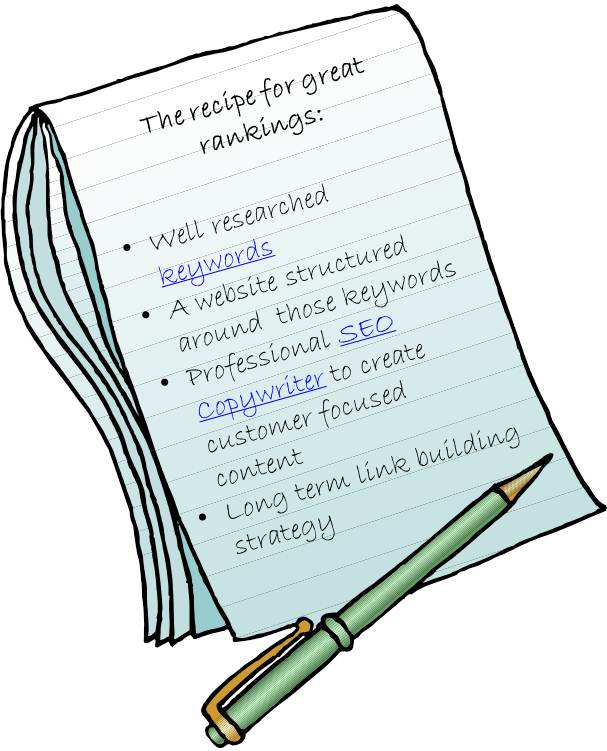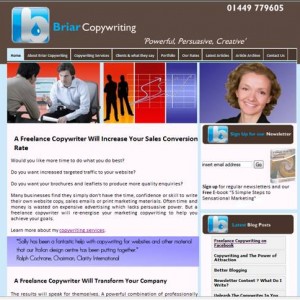Entries Tagged 'website copywriter' ↓
February 20th, 2012 — copywriter, copywriting tips, internet marketing, online copywriting, online marketing, website copywriter, website copywriting
 Let’s clear one thing up straight away, yes, I am a copywriter and of course I’m going to say you need someone like me to write your website copy for you.
Let’s clear one thing up straight away, yes, I am a copywriter and of course I’m going to say you need someone like me to write your website copy for you.
But, as you read on, I hope you’ll begin to understand exactly why it’s essential you use a website copywriter to get the most out of your online marketing strategy.
OK, so you’ve just spent a small fortune on your website’s design. It looks really cool, but it’s full of Lorem Ipsum so you now have to start thinking about content. Your web designer is champing at the bit to push your site live, but you’re dragging your feet because you have no idea what to write.
That’s when the suggestion is made…”why don’t you hire a professional copywriter to create your text for you?”
So, to explore the possibility you start getting quotes and then nearly fall of your chair when they start talking in the thousands of pounds (by the way, this fictional website is quite big).
Finally, you decide the only thing for it is to go it alone and get one of your office juniors to write it for you. The problem is they have no experience in writing for the web.
When your website is finally published, absolutely nothing happens – next to no traffic, no leads, nada, zero, zilch.
Why you need a website copywriter
Once you’ve paid for your new website, why let it go to waste by filling it with sub-standard copy?
Good copywriting doesn’t come cheap, but because you will be paying for a professional writer’s experience and expertise, it will be worth it.
You will save yourself a lot of time and a lot of frustration because the copy will actually work.
Why?
Simply because a copywriter will be able to produce copy that is:
- Written from a unique perspective (i.e. they can distance themselves from your company and put themselves in your customers’ shoes to make sure it offers the information they want to know)
- Written for your customers
- Benefits driven rather than all about your achievements as a company
- Visible to the search engines
- Compelling and persuades the reader to take action
- Designed to sell not inform
- Professional and reflective of your business and your brand
- Simple and unambiguous
Above all, it will provide you with a great return on investment because it will draw targeted traffic to your website and convert those visitors into sales.
If you’re expecting to pay a few pounds per page, forget it.
Good copywriters have been honing their craft for years. They know what works and what doesn’t work. They understand how search works and how to get the most from a page of copy. They have invested a lot in the knowledge they possess.
If you want to portray an image of professionalism online make sure you hire the best people – designers, photographers and copywriters.
It’s your image at stake – think about it.
October 7th, 2011 — brochure copywriting, conversion, copywriting tips, website copywriter, website copywriting
You’ve finally done it.
It was a job that remained on your to-do list for months, but finally, you’ve completed your new website copy or brochure content.
Your copy is error free (well, as far you can see), reads superbly and most importantly, can now be crossed off your to-do list.
Once it’s been uploaded or your shiny brochures have been received back from the printers (smelling divine), you sit back and wait for your phone to start ringing and the deluge of emails to pour into your inbox.
Strange, nothing’s happening…
Dogs can teach you a lot about copywriting
 These lovable rogues are my dogs – Jerry and Scooby.
These lovable rogues are my dogs – Jerry and Scooby.
As all dog owners will understand, they love to test my patience every time we go for a walk.
Jerry (the Springer Spaniel) is 11 now and slightly hard of hearing. Therefore, the commands he obeys are the ones he hears – and that’s not many.
Scooby (the Chocolate Labrador) on the other hand is only 5. He can hear and see me perfectly well, but that doesn’t mean he’ll always do as he’s told.
You see, Scooby has a condition known as ‘Intelligent Disobedience’. In other words, he’ll only do what I want him to do if there’s something in it for him.
The fields around us are littered with rather unpleasant dead rabbits (myxomatosis seems to be rife this year). There is nothing Scooby loves more than to find these rabbits and either play or attempt to eat them (dogs will be dogs).
If I tell him ‘no’ in a stern tone, his thought process goes something like this:
Hmmm, she wants me to put this rabbit down. But I found it so it’s mine. She’s not going to run across this ploughed field after me so, no, I’m not going to put it down.
A prime example of his Intelligent Disobedience – he’s thought about the command, decided there’s nothing it for him and therefore chooses to ignore me.
However, if I shout ‘no’ as I place my hand in my jacket pocket – the one he knows contains his favourite doggy treats – this is more likely to be his response:
I don’t want to put my rabbit down. Hang on, her hand’s in her pocket…hmmm, do I want a smelly rabbit or one of those delicious treats she buys me. No contest, goodbye rabbit – I’m coming mum!!
This time, even though Scooby didn’t really want to put his rabbit down he knew that if he did he would be rewarded with his favourite treat.
What on earth does this have to do with copywriting?
You are probably beginning to think I’ve finally lost it.
Bear with me, all will become clear.
Let’s go back to the copy we talked about at the start of this blog. Something’s wrong because it’s not converting readers into customers. Your readers are displaying their Intelligent Disobedience.
The most likely cause is that you haven’t written it for your reader. Everything you write must be aimed at your customers. It has to tell them what they want to know, not what you think they ought to know.
In a nutshell that means writing about the benefits of your product or service.
For example, if you were writing about a sofa and told your reader it comes in 6 colours, seats 3 people and has wooden casters, the most likely reaction would be ‘so what?’ That could relate to any sofa, you haven’t given them any good reasons to buy yours, therefore they have made the decision not to buy.
But if you told them:
- It’s made of hand stitched fine Italian leather
- It’s the latest design, so this is your chance to be the first to own such a luxurious piece of furniture
- It will transform any room, creating an air of chic luxury
- The same sofa is currently gracing no less than 3 movie star homes
Your reader is more likely to think ‘yes, I must have that sofa!’
Why?
Well, the first scenario simply tells them what the sofa is and doesn’t offer them anything in return for their investment.
Yes, I know, they will get the sofa – but’s that all.
In the second scenario, you are not only selling a sofa, you’re also selling a life style. Basically, it’s telling your reader that not only will they get the sofa, they’ll also own the latest design, a piece of furniture that will create an air of luxurious chic in their home, in fact a movie star life style!
An extreme example I grant you, but it serves as an illustration of how selling the benefits of your product will make your reader decided to buy.
Over to you
If you want to avoid Intelligent Disobedience in your customers, always make sure your copy sells the benefits of your products or services.
That means concentrating on what your product/service will do for your customer. Whether it’s aesthetic like the above example or more tangible (i.e. saving them money etc.), your customers will want to know what’s in it for them if they buy from you.
How do you sell the benefits of your product/service? Have you come up with any innovative techniques that really work? If so, leave a comment below and share them with us.
August 31st, 2011 — search engine optimisation, seo, SEO copywriter, seo website copywriter, website copywriter, website copywriting

From that list of ingredients, this post will look at the power of SEO copywriting.
When done well it will help your search engine rankings, attract readers and convert them into sales.
Done badly it could harm your rankings, repel customers and won’t convert a sausage.
So how can you make sure you get it right?
5 signs of good SEO copy
1. Write for your reader
There is a popular misconception that SEO copy has to be written for the search engines.
Wrong.
When writing your copy, always write it for your reader. Forget about keyword density – Google is more concerned with the amount of text, the topic you’re writing about (i.e. that your keywords in your title tags etc., are aligned with your content) and how hot the competition is for your particular keywords.
Always, always, always write to your reader first and foremost because they are the ones you want to read your copy and they are the ones you want to buy from you.
2. Don’t be repetitive
How many times have you read a website only to constantly hear the keywords being repeated?
Don’t stuff your copy with your keywords so it gets repetitive. After all if that was the only factor Google was interested in, all your competitor would have to do is insert one more keyword than you to rank higher.
And if that happened, the internet would be full of keyword-stuffed gibberish.
3. Don’t forget to link out
You already know the benefit of links into your website as part of your SEO strategy but don’t forget to link out too.
Linking out to authoritative articles not only adds to your reader experience and keeps Google happy; it could also help you attract inbound links.
4. Structure
Writing for the web is just like writing for anything else.
Your copy must be structured and attractive to the eye if you want people to read it.
Make sure it has a beginning, middle and an end with a strong headline. Split up your text into small paragraphs using sub headings as sign posts to help your reader skim the text.
Also, headings and subheadings are the ideal places for your primary and secondary keywords.
5. Be natural
There are loads of software programmes out there than can automate or spin articles for you. But they are no substitute for a well-considered, well-structured and well written article.
Don’t be tempted to use shortcuts.
So the moral of this post is to forget keyword density when it comes to your SEO copy. The most important thing to remember is to write for your reader. They are the ones you want to attract and they are the ones who you want to buy from you
July 6th, 2011 — copywriting tips, marketing, online marketing, website copywriter, website copywriting, website design
 That might sound like a strange question to ask.
That might sound like a strange question to ask.
But think about it for a second – why do you have a website?
If your immediate answer is ‘because everyone else has one’ you’re barking up the wrong tree.
Yes, if you’re in business today you are expected to have a web presence but that shouldn’t be the sole reason for your website to exist.
Your website has to do something for you and, more importantly, something for your customers. Let me explain.
Your website and you
By having an effective presence on the web you will be able to:
Free up manpower because your website should answer most of your customers’ questions
- Be a source of information 24/7
- Help people find you on the internet
- Publicise events and your latest news
- Showcase you products and services
- Take orders online
And that’s just for starters.
But it’s not just about that. Yes, all of those things will make your life easier and, to a certain extent, your customers’ lives. But your website isn’t just there to help you.
Your website and them
Who is ‘them’?
They are your customers. Your website is a 24 hour a day, 7 days a week interface between you and your customers. As such it must speak to them directly, address their needs and show them what you can do for them.
When they land on your website they want:
Great service
You see, for your customers the most important thing is what you’re going to do for them so first impressions are vital.
First impressions count
Whether you already have a website or are in the early stages of development, here are a few pointers to bear in mind when thinking about its design:
- Does it reflect you and your values?
- Can your customer tell what you do from the design/layout?
- Are your contact details easy to find?
- Does your website reflect your brand values?
- Does the copy talk to your reader?
- Is it selling you or the benefits of your service?
- Is it social?
When someone first lands on your website they should be able to instantly see what you do. Your website copy should be benefits led and your site navigation should be easy to use.
Also, make sure your contact details are prominent – after all, your customer is going to want to know that they can get hold of you if they need to. But you also need to consider social media. If it’s right for your business you must use social media – customers expect it. Make sure they can easily interact with you via Twitter and Facebook as well as via the telephone and email.
If you still think a website is just an online brochure, think again. Today your website must work for you. It has to show you are a progressive company that has embraced social media to open up the lines of communication with your customers.
It should be your primary marketing tool so make the most of it.
June 8th, 2011 — copywriting tips, website copywriter, website copywriting
 Take a look at your website.
Take a look at your website.
Have a quick read of it – have you we’d everywhere?
Far too many company websites out there are suffering from a nasty bout of incontinence. Their website copy is littered with we.
“We create wonderful furniture…”
“We take customer service seriously…”
“We have been working in this industry for 40 years…”
Do I look as though I care about any of that?
No!
As a customer looking through your website, I couldn’t give a toss about what your company’s achieved, how big your sales team is or how long you’ve been in business.
There’s only one thing I want to know and that’s what will your product/service do for me?
I want you to talk to me and tell me you’re going to make my life better. I want to hear about how you’re going to save me time, make me more glamorous or save me loads of money.
But to do that you’ve got to ditch the ‘we’ and replace it with ‘you’.
Website copywriting must address your reader at all times and that means writing in the second person.
Want an example?
OK, take a look at this text which I’ve taken from my website:
A Freelance Copywriter Will Increase Your Sales Conversion Rate
Would you like more time to do what you do best?
Do you want increased targeted traffic to your website?
Do you want your brochures and leaflets to produce more quality enquiries?
Many businesses find they simply don’t have the time, confidence or skill to write their own website copy, sales emails or print marketing materials. Often time and money is wasted on expensive advertising which lacks persuasive power. But a freelance copywriter will re-energise your marketing copywriting to help you achieve your goals.
See what I mean? All the way through the text I’m talking to the reader – no ‘we’ anywhere.
Granted I’m a website copywriter (just one of the many copywriting services I offer), but this is an effect that is simple to create.
When composing your web copy:
- Forget about your company
- Write as if you were talking to a customer who was standing in front of you
- Resist the urge to type ‘we’
Using the second person will help you make a connection with your reader. Make them feel as though they are the most important person in the world.
 Let’s clear one thing up straight away, yes, I am a copywriter and of course I’m going to say you need someone like me to write your website copy for you.
Let’s clear one thing up straight away, yes, I am a copywriter and of course I’m going to say you need someone like me to write your website copy for you.

 That might sound like a strange question to ask.
That might sound like a strange question to ask. Take a look at your website.
Take a look at your website.





